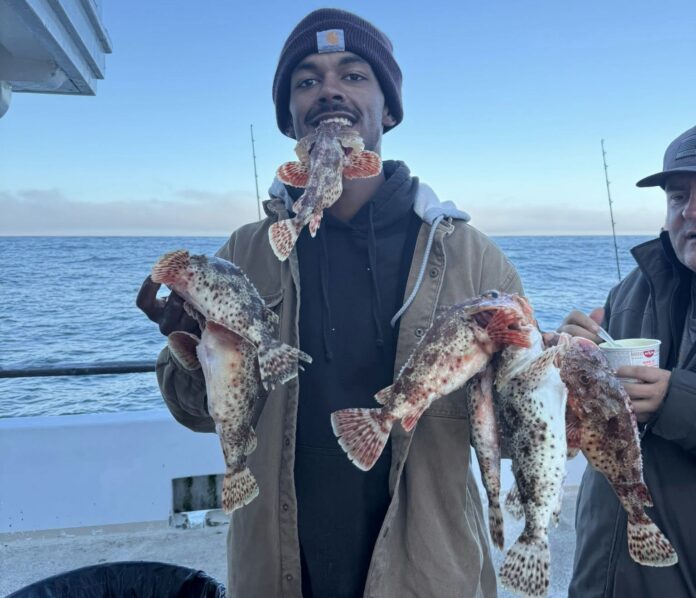BY MERIT McCREA
Ever imagine what’s actually under the boat where you’re fishing? I think we all do, whether we’re slow-rolling a swimbait or sinking a double-dropper rig into the depths. I’ve been fortunate enough to actually see a few of these places I’ve fished and imagined.
Sometimes it’s been enough dives or ROV surveys to really get familiar with the lay-out. Others it’s been just a dive on just a part of what’s really down there.
Usually one can only see a few yards out, either way.
The visibility is usually pretty limiting, especially within SCUBA depth. But even down deep where often it’s pretty clear, you’re limited to the glow of the lights of the submersible or ROV.
The story can be like the 2,600-year-old one about the blind men, each exploring just a part of an elephant, then arguing about what an elephant is like afterward.
That’s maybe what some of these experiences are, like at Izor’s. Others, like platforms Holly and Edith we have been fully explored, from wave-top to mud-line, inside and out.
Izors is an area of artificial reefs off Huntington Beach, out on the flats. Here’s the story.
As an angler, there are many different reefs in the Izor’s area – one which is about a mile-and-a-half in diameter in 95 to 100 feet of water. When you meter over the high spots it appears the taller reefs rise 15 or more feet off the bottom.
As an angler you get the impression that it’s made of razor blades the way hooked fish tend to hook you up in the reef and cut you off. You get bit, swing, the rod doubles over, you get a few solid tugs, then things get scratchy and the line busts. Sometimes you swing and the line just parts instantly.
Anchoring is sketchy because you never know if you’ll get it back. The strategy is to drop a ways up drift of the spot, and scope back. But often the hook drags along until it finds the reef instead.
So that’s what happened to me. And no matter how hard I tried, dead lift winding down between swells and tying off, letting the sea lift the bow with max force, slacking and pulling from this way and that, it just wouldn’t pop the trip or pull free. That chain was hung tight.
So, we unhooked the line at the swivel between the shallow water section and the bottom-of-the-box back-up and buoyed it off. There it sat for a couple months.
The Love Lab scientific diving crew got together for a recreational dive in those deep waters finally – Katelin Seto, Conner Jainese and I. We tied off to the buoy and down the line we went.
What we found was crazy. Clean, warm and blue for the upper 50 feet, it looked like bottom at first, but it’s just the thermocline, with cold green water under it.
Going through is like hitting the surface all over again, this time into a different ocean, cold, green, maybe 20 feet of vis. At 65 feet the hazy top of the structure comes barely into view – l pile of pilings.
The line went down to the outer edge of the heap. There it is clear why I had been unable to pop the trip on the top of the anchor and free the hook.
Two of these massive, octagonal 40-foot-long beams are nearly parallel on the bottom, but crossed and suspended a few feet off the clean white sand.
The chain had slid between them and wedged in the crux. Extricating the anchor takes swimming the thing some 20 feet west to where the gap is wide enough to pull the hook back through. Other beams underneath had kept that from happening when pulled from the surface.
Meanwhile there are other busted off anchors scattered around within a few yards. We gather several up and tie them off to our anchor line.
Swimming to the top of the pile, it was more like a giant jungle gym than a pile of rock. Hanging suspended atop the pile at 80-some feet down you can see through the pile to white sands below.
Between those beams huge sand bass and sheephead course along the bottom. More are suspended among the crisscrossed concrete pilings, beams festooned with angling failures, lines and leadheads busted off in defeat.
Deep, our permitted no-deco bottom time is limited. We meet back at our anchor. Conner brings in one more rusty anchor to the pile.
I consider the heap – now a handful of small skiff anchors and chain including ours, and whether the commercial trap puller would handle all that weight. It’s far beyond what we could hand-pull for sure, so if overloaded, we might be stuck leaving everything behind once again.
I waved Conner off, and we left that one on bottom.
It’s not likely all the reefs put down at Izor’s are made of the same stuff as that one. But it was instantly clear why so many big fish earn back their freedom there.
Merit McCrea is SoCal saltwater editor for Western Outdoor News. A veteran Southern California partyboat captain, he is the Science and Fisheries Coordinator for the Sportfishing Association of California and a marine research scientist with the Dr. Milton Love Lab at the University of California at Santa Barbara’s Marine Science Institute. He currently serves on the Groundfish Advisory sub-Panel of the Pacific Fisheries Management Council, the Santa Barbara Harbor Commission, and the CCA-Cal State Board. He can be reached at: merit@wonews.com.




